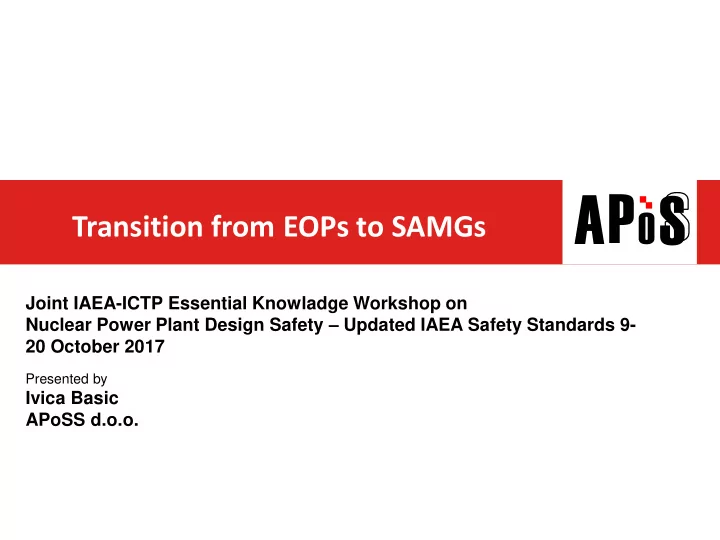

A S P O Transition from EOPs to SAMGs Joint IAEA-ICTP Essential Knowladge Workshop on Nuclear Power Plant Design Safety – Updated IAEA Safety Standards 9- 20 October 2017 Presented by Ivica Basic APoSS d.o.o.
A S P O Overview • EOP entrance/exit criteria • SAMG entry/exit criteria – Various examples • References 2
A S P O Principle of Transition EOP-SAMG • Accidents are, in principle, covered by EOPs – e.g.: LOCA, SGTR, ATWS, SBO • EOPs go way beyond DBA – e.g. up to probability of 1.0E-08 (WOG EOPs) – EOPs include non-conventional cooling • May include cooling by non-qualified water sources • But the EOPs may not be able to prevent core damage – Operator has done everything he could, there is no way left to cool the core, all is tried but failed – THAT is the moment to enter SAMG
A S P O Entry/exit criteria EOP • Entry into EOP from AOP is usually through occurrence of scram or safety system actuation – Entry is followed by diagnosis according to e.g. E-0 (WOG approach) • Exit from EOP to SAMG is imminent or actual core damage
A S P O Westinghouse AMP Concept
A S P O World of SAMG is different! Domain of SAMG is big drama: • Plant is lost • Life maybe in danger – also life of family • Plant status confusing – what is going on??? – ´half of instrumentation is red, other half is dead’ • Needed actions can be conflicting, and maybe contrary to ´ normal ´ actions (i.e. in EOP-domain): – EOP-space: spraying the containment is okay, – SAMG space: spraying may de-inert containment atmosphere: hydrogen burn?? • Outcome of actions can be uncertain
A S P O When is there core damage? Inside DBA: ECCS design criteria to be observed (1200 ° C, 17% • clad oxidation) • Outside DBA: higher temp. / oxidation can be accepted, but mass of molten corium should still be around 0 kg. • Investigation of amount of molten mass in TACIS/PHARE project, using MELCOR calculations
A S P O Estimate of core damage (VVER - example) Entrance into Amount of molten Strategies FR-C.1 mass in vessel 550 ° C 0 kg All C.1 strategies effective 650 ° C 0 kg Sec. depressurisation not effective 750 ° C 150 kg None of C.1 strategies effective
A S P O PWR transient at threshold of FR.C-1 (example) PCT 1800 ° C 5 -10 min. time
A S P O Engineered transition criteria • Must have observable criteria – No time to do calculations • There is a wide scatter in such criteria – Each vendor / Owners Group has its own criteria – Examples: WOG, CEOG, B&WOG, EdF GIAG (~ SAMG in French), Areva (EPR)
A S P O WOG - transition criteria Westinghouse Owners Group SAMG: • Entry conditions SAMG defined by exit of EOPs: – FR-C.1: core exit T max AND all recovery failed (i.e., core damage unavoidable) – FR-S.1: core exit above T max – ECA 0.0: core exit above T max T max = ca. 550 – 650 ° C, is plant specific T max is ‘red entry’ into FR -C.1 (but there recovery is available) EOPs exited; all actions that remain useful are also in SAMG.
A S P O CEOG - transition criteria Combustion Engineering Owners Group SAMG: • EOPs are not formally exited! SAMG executed in parallel, but consistency checked, priority always with SAMG • Entry into SAMGs is decision of Site Emergency Director (SED), not MCR, basis is not just CET (core exit T) • Basis: – flow insufficient to cool the core – level indication ~ 0% – CET 10 ° C superheat and rising
Babcock & Wilcox Owners Group transition criteria EOP - A S P O SAMG
A S P O EdF - transition criteria • CET 1100 ° C or activity inside containment according to table – prevents too early transition • Decision by plant headquarters
A S P O OSSA (Areva, France)
A S P O Transition Criteria EOP – SAMG, organizational aspects Not only system parameters are relevant, also readiness of organisation : • ERO (TSC) must be operational • Operational means: TSC understands the situation and is ready to give its first recommendation ; NOT: TSC has arrived and has assembled in their room! • Make sure guidance is in place if TSC is not yet operational (needed for e.g. ATWS); in WOG: SACRG-1
A S P O Example of ERO, note the Accident Management Team
A S P O Exit from SAMG • SAMG is not a long-term concept • Dependent on accident evolution decisions on long-term provisions – cooling – power – treatment of run-off water – decontamination
A S P O Exit of SAMG (cont’d) Example from Westinghouse: • Core temp. < [x] AND stable or decreasing • Site releases < [y] AND stable or decreasing • Containment pressure < [z] AND stable or decreasing • Containment hydrogen < [u] AND stable or decreasing
A S P O Conclusions • Various approaches for the transition EOP-SAMG, basis: imminent or actual core damage • Transition includes not only a change in guidelines, but is a fully different approach – be aware of this! • Transition should be clearly described, including all organisational changes • Avoid any time gap in the transition – no pause in the handling of the accident • Exit to long-term provisions: also needed
A S P O References „ Transition from EOPs to SAMG „ , George Vayssier, [1] IAEA SAMG workshop, 10-14 December 2012, Islamabad, Pakistan
A S P O END Questions? Comments? Thanks for your attention!
Recommend
More recommend